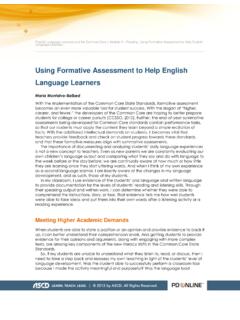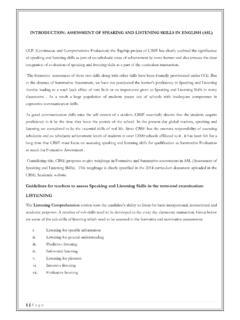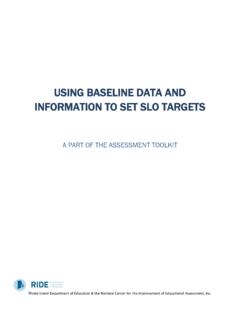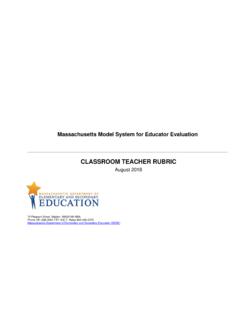Transcription of 2005Policy Brief - OECD
1 NOVEMBER 2005. Policy Brief ORGANISATION FOR ECONOMIC CO-OPERATION AND DEVELOPMENT. formative assessment : Improving Learning in Secondary Classrooms What are the Introduction benefits of formative Are pupils learning enough, and learning it well in secondary school assessment ? classrooms and how can you tell? Can schools and teachers not only measure the progress made by pupils, but also identify their learning needs What does formative and respond to them? Effective assessment is needed to provide effective assessment involve answers to all these critical questions. in practice? Tests and examinations are a classic way of measuring student progress and What are the major are integral to accountability of schools and the education system.
2 These barriers to wider use of highly visible forms of tracking progress, known as summative assessment . formative assessment ? are also used by parents and employers. But this is only part of the story. To be truly effective, assessment should also How can school be formative in other words, identifying and responding to the students'. leaders and teachers learning needs. In classrooms featuring formative assessment , teachers make address school- frequent, interactive assessments of student understanding. This enables level barriers? them to adjust their teaching to meet individual student needs, and to better help all students to reach high standards. Teachers also actively involve How can policy students in the process, helping them to develop skills that enable them to promote effective learn better.
3 Teaching and assessment Many teachers incorporate aspects of formative assessment into their across systems? teaching, but it is less common to find it practised systematically. If formative assessment is used as a framework for teaching, teachers change the way How to promote they interact with students, how they set up learning situations and guide formative students toward learning goals, even how they define student success. assessment ? Several countries promote formative assessment as a fundamental approach to education reform. The OECD has studied the use of formative assessment Do formative in eight educational systems: Australia (Queensland), Canada, Denmark, assessment methods England, Finland, Italy, New Zealand and Scotland.
4 The study has also hold promise for brought together reviews covering English, French and German language adult learners? research literature. This Policy Brief looks at the results of that study, including policy principles to address barriers to formative assessment and encourage For further its wider use.. information For further reading Where to contact us? OECD 2005. Policy Brief formative assessment : IMPROVING LEARNING IN SECONDARY CLASSROOMS. What are the formative assessment has been shown to be highly effective in raising the benefits of formative level of student attainment, increasing equity of student outcomes, and assessment ? improving students' ability to learn.
5 The achievement gains associated with formative assessment have been described as among the largest ever reported for educational interventions . The study carried out by the OECD's Centre for Educational Research and Innovation (CERI) supports these findings. formative assessment also improves equity of student outcomes. Schools which use formative assessment show not only general gains in academic achievement, but also particularly high gains for previously underachieving students. Attendance and retention of learning are also improved, as well as the quality of students' work. Several countries have introduced or are developing standards for student performance. But some argue that there is an inherent contradiction between such centralised standards and the individualisation of learning implied in the formative assessment model.
6 Certainly the idea of standards suggests a level of uniformity. Moreover, high-visibility tests that hold schools accountable for meeting centralised standards may aggravate this situation. But formative assessment methods are not necessarily at odds with standards and testing. Teachers may still work toward standards while identifying the factors behind the variation in students' achievements and adapting their teaching to meet individual needs. Exemplary schools are making progress in closing the gaps in student achievement while recognising individual and cultural differences. formative assessment builds students' learning to learn skills by emphasising the process of teaching and learning, and involving students as partners in that process.
7 It also builds students' skills at peer- assessment and self- assessment , and helps them develop a range of effective learning strategies. Students who are actively building their understanding of new concepts (rather than merely absorbing information) and who are learning to judge the quality of their own and their peers' work against well-defined criteria are developing invaluable skills for lifelong learning.. What does formative There are several key elements for a successful use of formative assessment assessment involve in secondary schools (See also Box 1). in practice? Teachers using formative assessment have changed the culture of their classrooms, putting the emphasis on helping students feel safe to take risks and make mistakes and to develop self-confidence in the classroom.
8 Teachers working with students from backgrounds other than their own also make efforts to understand cultural preconceptions. They interact frequently with individual or small groups of students and involve students in the assessment process, providing them with tools to judge the quality of their own work. Teachers also make the learning process more transparent by establishing and communicating learning goals, tracking student progress and, in some cases, adjusting goals to better meet student needs. Teachers are able to compare their assessments with other teachers to ensure that they are treating students equitably. They often find that comments are more effective than marks for improving student performance and helping all students to reach high standards.
9 It is not always easy to drop or decrease the frequency 2 OECD 2005. Policy Brief formative assessment : IMPROVING LEARNING IN SECONDARY CLASSROOMS. of marks, however. Sometimes students and their parents prefer to know how they are doing relative to other students. To meet a range of student needs, teachers vary instruction methods. They ensure that lessons include different approaches to explaining new concepts, provide options for independent classroom work, and encourage students who have grasped a new concept to help their peers. Teachers use a mix of approaches to assess student understanding of what has been taught. They may use diagnostic assessment to determine a student's level when he or she first enters a new school or at specified times during the school term to help shape teaching strategies.
10 During classroom interactions, they most often use questioning techniques. Questions regarding causality, or open-ended questions, for example, often reveal student misconceptions. For example, biology teachers in one of the case study schools started asking students what would happen if chlorophyll stopped working, and discovered a common misconception that the entire world would be dark. Teachers may provide verbal or written feedback on student's work. Teachers and researchers have found that the most effective feedback is timely, specific and tied to explicit criteria. Teachers also adjust their strategies to meet needs identified in assessment . Box 1. Teachers across the case study schools developed a number of techniques to better formative assessment diagnose and respond to student needs.
















